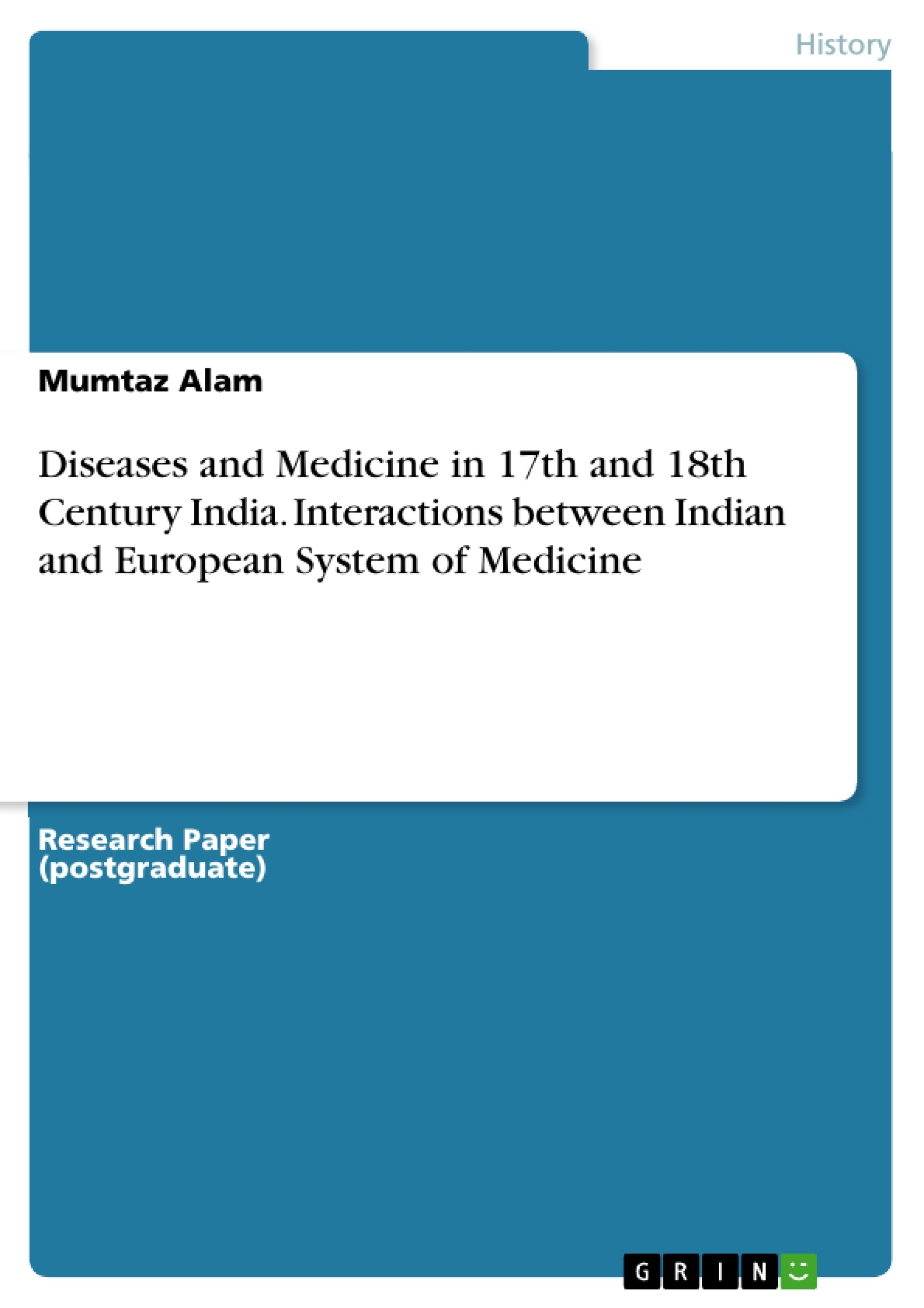The Portuguese were the first who introduce the European system of medicine in India. Initially, they came as ship physicians and surgeons. Later, at the city ports of Gujarat the British, the French and Italian physicians came. With their arrival a new system of medicine was introduced. Nonetheless, in the initial stage it was they who benefitted more from the Indigenous systems rather than the other way round. One of the early trained European to land in India was Garcia da Orta who lived and worked in Goa (1538-68).The Linschotin account here mentioned about the various medicinal plants and their uses.There were interaction between these two systems divided into three phases.
Inhaltsverzeichnis (Table of Contents)
- Diseases and Medicine in 17th and 18th Century India: Interactions between Indian and European System of Medicine
Zielsetzung und Themenschwerpunkte (Objectives and Key Themes)
The objective of this paper is to analyze the knowledge of diseases and medicines as it was known in 17th and 18th century India and to understand the interactions between the Indian system of medicine and the Western knowledge introduced by European practitioners.
- Interactions between Indian and European medical systems in 17th and 18th century India.
- The knowledge and practices of Indian physicians as described by European observers.
- The perceptions and biases of European physicians towards Indian medical practices.
- The role of European physicians in the Mughal court and other parts of India.
- The state of hospitals and medical care in 17th and 18th century India.
Zusammenfassung der Kapitel (Chapter Summaries)
Diseases and Medicine in 17th and 18th Century India: Interactions between Indian and European System of Medicine: This chapter explores the interactions between Indian and European systems of medicine during the 17th and 18th centuries in India. It examines the accounts of several European physicians who visited India, highlighting their observations on Indian medical practices, climate, and the conditions of the people. The chapter acknowledges that many of these European physicians were self-taught, lacking formal medical training. Despite their lack of formal training, their writings offer valuable insights into the medical knowledge and practices prevalent in India at the time. The chapter sets the stage for a deeper analysis of the interactions between Indian and Western medical knowledge, focusing on the perspectives and biases present in the accounts of these European observers. It also emphasizes the limitations of relying solely on the accounts of "mercenary" Western practitioners for a complete understanding of the Indian medical system. The contrasting viewpoints of Niccolao Manucci, who was self-taught yet provided extensive commentary, lays the groundwork for a more nuanced understanding of the historical context. The chapter introduces the key players and their varying levels of medical expertise, establishing a framework for the subsequent analysis of the period's medical landscape.
Schlüsselwörter (Keywords)
17th century India, 18th century India, Indian medicine, European medicine, medical interactions, Mughal Empire, European physicians, Indian physicians, medical practices, hospitals, colonial India.
Diseases and Medicine in 17th and 18th Century India: FAQ
What is the main objective of this paper?
The paper analyzes the knowledge of diseases and medicines in 17th and 18th century India, focusing on the interactions between the Indian system of medicine and Western knowledge introduced by European practitioners.
What are the key themes explored in this paper?
Key themes include the interactions between Indian and European medical systems, the knowledge and practices of Indian physicians as described by European observers, the perceptions and biases of European physicians towards Indian medical practices, the role of European physicians in the Mughal court and other parts of India, and the state of hospitals and medical care in 17th and 18th century India.
What is covered in the chapter "Diseases and Medicine in 17th and 18th Century India: Interactions between Indian and European System of Medicine"?
This chapter explores the interactions between Indian and European medical systems during the 17th and 18th centuries in India. It examines accounts from European physicians, highlighting their observations on Indian medical practices, climate, and the conditions of the people. It acknowledges the lack of formal medical training in many of these European physicians, emphasizing the value and limitations of their accounts. The chapter sets the stage for a deeper analysis of the interactions between Indian and Western medical knowledge, focusing on perspectives and biases. It also stresses the need for a nuanced understanding beyond the accounts of "mercenary" Western practitioners, introducing key figures and their varied levels of medical expertise.
What are the key words associated with this research?
Key words include 17th century India, 18th century India, Indian medicine, European medicine, medical interactions, Mughal Empire, European physicians, Indian physicians, medical practices, hospitals, and colonial India.
What sources of information were used in this research?
The primary sources appear to be the writings and observations of European physicians who practiced in 17th and 18th century India. The analysis considers their perspectives and acknowledges the limitations inherent in relying solely on these accounts for a complete understanding of the Indian medical system.
What is the overall scope of this research?
The research aims to provide a comprehensive overview of the medical landscape of 17th and 18th century India, examining the interplay between indigenous and European medical practices. It emphasizes the importance of considering the perspectives and biases of both Indian and European practitioners to achieve a balanced understanding of the historical context.
- Quote paper
- Mumtaz Alam (Author), 2011, Diseases and Medicine in 17th and 18th Century India. Interactions between Indian and European System of Medicine, Munich, GRIN Verlag, https://www.hausarbeiten.de/document/182021


